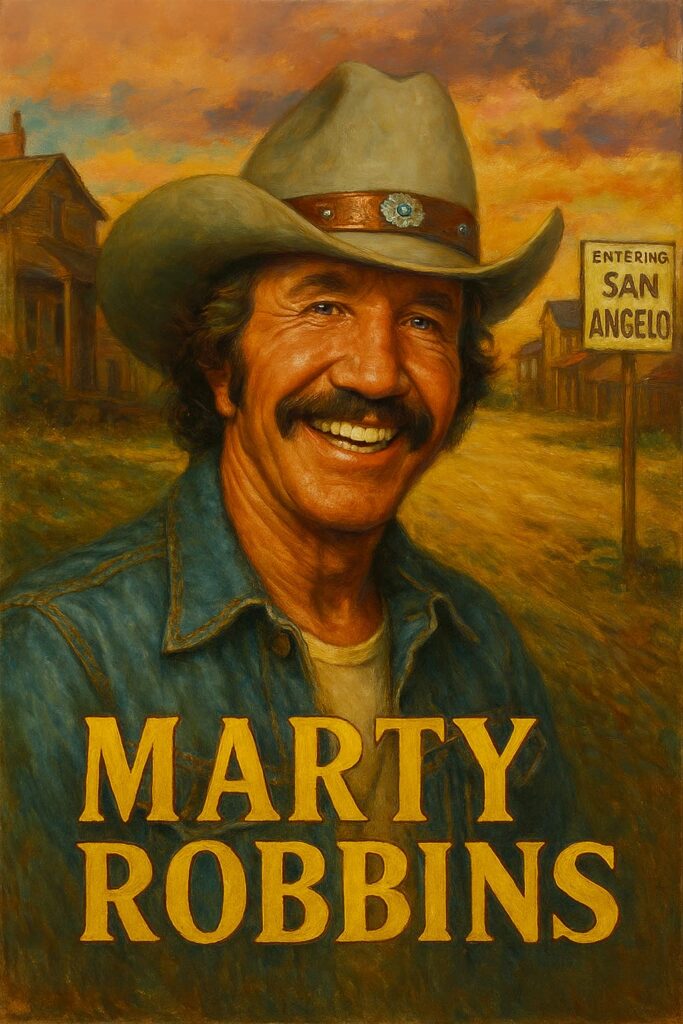
Marty Robbins’ “San Angelo”: A Melancholy Ballad of Lost Love and Haunting Memories
There are some songs that, upon hearing the first few notes, immediately transport you back to a simpler time, a time when stories were told with melodies and heartache echoed through dusty plains. Such is the enduring power of Marty Robbins’ “San Angelo,” a poignant ballad that unfurls like a sepia-toned photograph, capturing the essence of lost love, a daring outlaw’s tragic fate, and the haunting beauty of a frontier town. Released in 1960 on his album More Gunfighter Ballads and Trail Songs, “San Angelo” arrived on the heels of his monumental success with “El Paso,” and while it didn’t quite replicate the chart-topping glory of its predecessor, it nonetheless became a beloved classic in the Marty Robbins canon.
Unlike “El Paso,” which soared to number one on both the Billboard Hot Country Songs and Hot 100 charts, “San Angelo” found its home primarily within the country music landscape, becoming a cherished track for fans of Robbins’ signature narrative style. While exact peak chart positions for “San Angelo” as a single are not as readily available as for his bigger hits, its presence on the follow-up album to Gunfighter Ballads and Trail Songs solidified its place as a significant contribution to his discography and a testament to the continued popularity of his cowboy ballads. Its enduring presence on platforms like Spotify and YouTube, accumulating millions of streams and views, speaks volumes about its lasting appeal, even decades after its initial release.
The story behind “San Angelo” is one of desperation and doomed romance, a familiar yet ever-captivating theme in Marty Robbins’ repertoire. It tells the tale of an outlaw, much like the protagonist of “El Paso,” who can no longer bear to be apart from the woman he loves, a cantina girl named Secora. Driven by an unstoppable longing, he rides to the Texas town of San Angelo, fully aware of the immense danger awaiting him. He’s a wanted man, and the town is riddled with those who seek to bring him to justice – or perhaps simply claim the bounty on his head.
The beauty of Robbins’ storytelling lies in the vivid imagery he paints: “A hot sun was glowing, a warm wind was blowing, still not as warm as the lips that I waited to kiss.” We feel the heat of the day, the anticipation in the outlaw’s heart, and the desperate hope for a reunion. He describes Secora with breathtaking tenderness: “Cheeks that put blushing red roses to shame, lips that were fresher than flowers when kissed by the rain.” This is not just a woman; she is the sun, the rain, the very breath of life to him.
The tension builds as the outlaw arrives in San Angelo, searching for Secora at their appointed meeting place. The air is thick with unease, a sense of foreboding that grows with each verse. He spots a rifleman on a rooftop, and then realizes there are others, hidden from view. He’s trapped, but his love for Secora won’t let him flee. And then, in a moment of heart-wrenching tragedy, Secora herself appears, running to warn him, only to be struck down by a bullet. “She dies as she falls in my arms,” he sings, a line that still sends shivers down the spine, a testament to the raw emotion Robbins could convey.
The meaning of “San Angelo” transcends a simple cowboy tale. It’s a profound exploration of sacrifice, the overwhelming power of love in the face of death, and the brutal reality of a life lived on the fringes of the law. The outlaw, consumed by grief and vengeance, takes swift revenge on the ranger who killed Secora, but his act of defiance only seals his own fate. As he falls, mortally wounded, his final moments are spent blindly reaching for Secora’s hand. “Life is no more but we’re together,” he whispers, finding solace in their shared demise, a chilling yet strangely comforting notion that love triumphs even over the grave.
For those of us who grew up listening to the rich narratives of artists like Marty Robbins, “San Angelo” evokes a particular kind of nostalgia. It takes us back to long car rides with crackling radio waves, to evenings spent imagining ourselves in those dusty towns, living lives of grand passion and perilous adventure. It’s a reminder of a time when songs were not just catchy tunes, but meticulously crafted stories, each word a brushstroke on a canvas of human emotion. “San Angelo” remains a powerful testament to Marty Robbins’ unparalleled ability to weave tales of the American West, infusing them with a timeless appeal that continues to resonate with generations. It’s a song that proves, without a shadow of a doubt, that some memories, even the tragic ones, are meant to be cherished, remembered, and replayed again and again.